Smartphone-Based Indoor Floor Plan Construction via Acoustic Ranging and Inertial Tracking †
Abstract
1. Introduction
- We explore a novel unilateral acoustic ranging method on a commodity smartphone. It transmits acoustic signals to the side walls for distance measurements, so users can simply surround the building, constructing its wall structure with lightweight manpower.
- We propose a map refinement algorithm to produce precise and complete multi-level floor plans by smartphones. It automatically adjusts and merges the scattered wall segments, and identifies connection areas (e.g., stairs and elevators) on the map.
- We propose an indoor navigation method based on Dynamic Time Warping (DTW). It automatically matches the reference sequence collected when constructing the map with the user’s real-time walking sequence, thus provides the user with fine-grained navigation.
- We develop a prototype and conduct extensive experiments in a teaching building and a residential building. Results have shown our improvements with around 2.8% on F-score compared to BatMapper, and the distance error of indoor navigation is less than 1.5 m.
2. Overview
2.1. Background on BatMapper
2.2. BatMapper-Plus Overview
3. Indoor Floor Plan Construction
3.1. Unilateral Acoustic Ranging
3.1.1. Acoustic Signal Design
3.1.2. Delay of Echo Signal
3.1.3. Distance to Wall
3.2. Inertial Tracking
3.2.1. Step Counting
3.2.2. Step Length Inference
3.2.3. Heading Orientation Estimation
3.3. Map Construction and Refinement
3.3.1. Floor Plan Refinement
3.3.2. Door and Window Detection
3.3.3. Connection Area Detection
4. Indoor Navigation
4.1. Reference Sequence Construction
4.2. DTW with Step Count Constraints
| Algorithm 1: DTW algorithm with step count constraints |
|
4.3. Leading Back Incorrect Route
4.4. Trajectory Correction
5. Results
5.1. Unilateral Acoustic Ranging
5.2. Floor Plan Construction
5.3. Connection Area Detection
5.4. Consumption
5.5. Indoor Navigation
6. Discussion
6.1. Indoor Floor Plan Construction
6.2. Indoor Navigation
7. Related Work
7.1. Indoor Floor Plan Construction
7.2. Acoustic Ranging
7.3. Inertial Tracking
7.4. Indoor Navigation
8. Conclusions
Author Contributions
Funding
Data Availability Statement
Conflicts of Interest
References
- Wang, X.; Marcotte, R.J.; Olson, E. GLFP: Global localization from a floor plan. In Proceedings of the IEEE/RSJ International Conference on Intelligent Robots and Systems (IROS), Venetian Macao, Macau, 3–8 November 2019; pp. 1627–1632. [Google Scholar]
- Anderson, R.; Curro, J. Indoor Navigation Using Convolutional Neural Networks and Floor Plans. In Proceedings of the ION GNSS+, Denver, CO, USA, 19–23 September 2021; pp. 2133–2150. [Google Scholar]
- Harithas, S.S.; Pardia, B. GenNav: A Generic Indoor Navigation System for Mobile Robots. In Proceedings of the IEEE I-SMAC, Palladam, India, 7–9 October 2020; pp. 182–187. [Google Scholar]
- Gao, R.; Zhao, M.; Ye, T.; Ye, F.; Luo, G.; Wang, Y.; Bian, K.; Wang, T.; Li, X. Multi-story indoor floor plan reconstruction via mobile crowdsensing. IEEE Trans. Mob. Comput. 2016, 15, 1427–1442. [Google Scholar] [CrossRef]
- Zhou, B.; Elbadry, M.; Gao, R.; Ye, F. BatMapper: Acoustic sensing based indoor floor plan construction using smartphones. In Proceedings of the ACM MobiSys, Niagara Falls, NY, USA, 19–23 June 2017; pp. 42–55. [Google Scholar]
- Meng, C.; Jiang, S.; Wu, M.; Xiao, X.; Tao, D.; Gao, R. BatMapper-Plus: Smartphone-Based Multi-level Indoor Floor Plan Construction via Acoustic Ranging and Inertial Sensing. In Proceedings of the International Conference on Wireless Algorithms, Systems, and Applications, Dalian, China, 24–26 November 2022; Springer: Cham, Switzerland; pp. 155–167. [Google Scholar]
- Pradhan, S.; Baig, G.; Mao, W.; Qiu, L.; Chen, G.; Yang, B. Smartphone-based acoustic indoor space mapping. Proc. ACM Interact. Mob. Wearable Ubiquitous Technol. 2018, 2, 1–26. [Google Scholar] [CrossRef]
- Keogh, E.; Ratanamahatana, C.A. Exact indexing of dynamic time warping. Knowl. Inf. Syst. 2005, 7, 358–386. [Google Scholar] [CrossRef]
- Plouffe, G.; Cretu, A.M. Static and dynamic hand gesture recognition in depth data using dynamic time warping. IEEE Trans. Instrum. Meas. 2015, 65, 305–316. [Google Scholar] [CrossRef]
- Alzantot, M.; Youssef, M. Crowdinside: Automatic construction of indoor floorplans. In Proceedings of the 20th International Conference on Advances in Geographic Information Systems, Redondo Beach, CA, USA, 6–9 November 2012; pp. 99–108. [Google Scholar]
- Peng, Z.; Gao, S.; Xiao, B.; Wei, G.; Guo, S.; Yang, Y. Indoor floor plan construction through sensing data collected from smartphones. IEEE Internet Things J. 2018, 5, 4351–4364. [Google Scholar] [CrossRef]
- Luo, H.; Zhao, F.; Jiang, M.; Ma, H.; Zhang, Y. Constructing an indoor floor plan using crowdsourcing based on magnetic fingerprinting. Sensors 2017, 17, 2678. [Google Scholar] [CrossRef] [PubMed]
- Chen, S.; Li, M.; Ren, K.; Fu, X.; Qiao, C. Rise of the indoor crowd: Reconstruction of building interior view via mobile crowdsourcing. In Proceedings of the ACM SenSys, Seoul, Republic of Korea, 1–4 November 2015; pp. 59–71. [Google Scholar]
- Li, Z.; Zhao, J.; Zhou, X.; Wei, S.; Li, P.; Shuang, F. RTSDM: A Real-Time Semantic Dense Mapping System for UAVs. Machines 2022, 10, 285. [Google Scholar] [CrossRef]
- Mao, W.; Sun, W.; Wang, M.; Qiu, L. DeepRange: Acoustic ranging via deep learning. Proc. ACM Interact. Mob. Wearable Ubiquitous Technol. 2020, 4, 1–23. [Google Scholar] [CrossRef]
- Liu, Z.; Chen, R.; Ye, F.; Guo, G.; Li, Z.; Qian, L. Improved TOA estimation method for acoustic ranging in a reverberant environment. IEEE Sens. J. 2020, 22, 4844–4852. [Google Scholar] [CrossRef]
- Shen, G.; Chen, Z.; Zhang, P.; Moscibroda, T.; Zhang, Y. {Walkie-Markie}: Indoor Pathway Mapping Made Easy. In Proceedings of the USENIX NSDI, Lombard, IL, USA, 2–5 April 2013; pp. 85–98. [Google Scholar]
- Rai, A.; Chintalapudi, K.K.; Padmanabhan, V.N.; Sen, R. Zee: Zero-effort crowdsourcing for indoor localization. In Proceedings of the ACM MobiCom, Istanbul, Turkey, 22–26 August 2012; pp. 293–304. [Google Scholar]
- Zhao, M.; Ye, T.; Gao, R.; Ye, F.; Wang, Y.; Luo, G. Vetrack: Real time vehicle tracking in uninstrumented indoor environments. In Proceedings of the ACM SenSys, Seoul, Republic of Korea, 1–4 November 2015; pp. 99–112. [Google Scholar]
- Zhang, Z.Q.; Meng, X. Use of an inertial/magnetic sensor module for pedestrian tracking during normal walking. IEEE Trans. Instrum. Meas. 2014, 64, 776–783. [Google Scholar] [CrossRef]
- Ma, J.; Duan, X.; Shang, C.; Ma, M.; Zhang, D. Improved Extreme Learning Machine Based UWB Positioning for Mobile Robots with Signal Interference. Machines 2022, 10, 218. [Google Scholar] [CrossRef]
- Gozick, B.; Subbu, K.P.; Dantu, R.; Maeshiro, T. Magnetic maps for indoor navigation. IEEE Trans. Instrum. Meas. 2011, 60, 3883–3891. [Google Scholar] [CrossRef]
- Evennou, F.; Marx, F. Advanced integration of WiFi and inertial navigation systems for indoor mobile positioning. EURASIP J. Adv. Signal Process. 2006, 2006, 1–11. [Google Scholar] [CrossRef]
- Altini, M.; Brunelli, D.; Farella, E.; Benini, L. Bluetooth indoor localization with multiple neural networks. In Proceedings of the IEEE 5th International Symposium on Wireless Pervasive Computing, Modena, Italy, 5–7 May 2010; pp. 295–300. [Google Scholar]
- Ayyalasomayajula, R.; Arun, A.; Wu, C.; Sharma, S.; Sethi, A.R.; Vasisht, D.; Bharadia, D. Deep learning based wireless localization for indoor navigation. In Proceedings of the 26th Annual International Conference on Mobile Computing and Networking, London, UK, 21–25 September 2020; pp. 1–14. [Google Scholar]
- Zhou, Y.; Law, C.L.; Guan, Y.L.; Chin, F. Indoor elliptical localization based on asynchronous UWB range measurement. IEEE Trans. Instrum. Meas. 2010, 60, 248–257. [Google Scholar] [CrossRef]
- Xu, C.; Liu, Z.; Li, Z. Robust visual-inertial navigation system for low precision sensors under indoor and outdoor environments. Remote Sens. 2021, 13, 772. [Google Scholar] [CrossRef]
- Khan, D.; Ullah, S.; Nabi, S. A generic approach toward indoor navigation and pathfinding with robust marker tracking. Remote Sens. 2019, 11, 3052. [Google Scholar] [CrossRef]
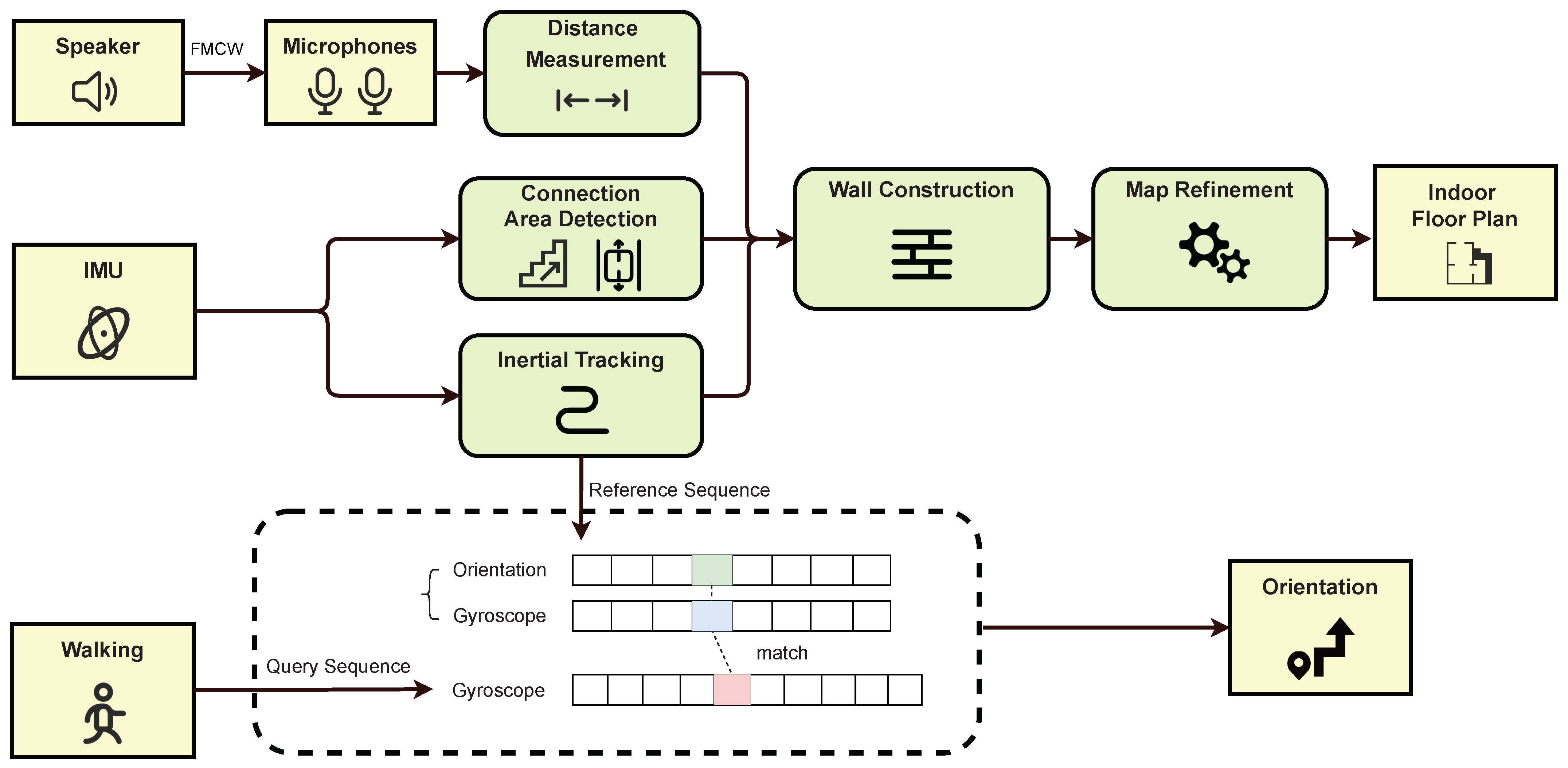
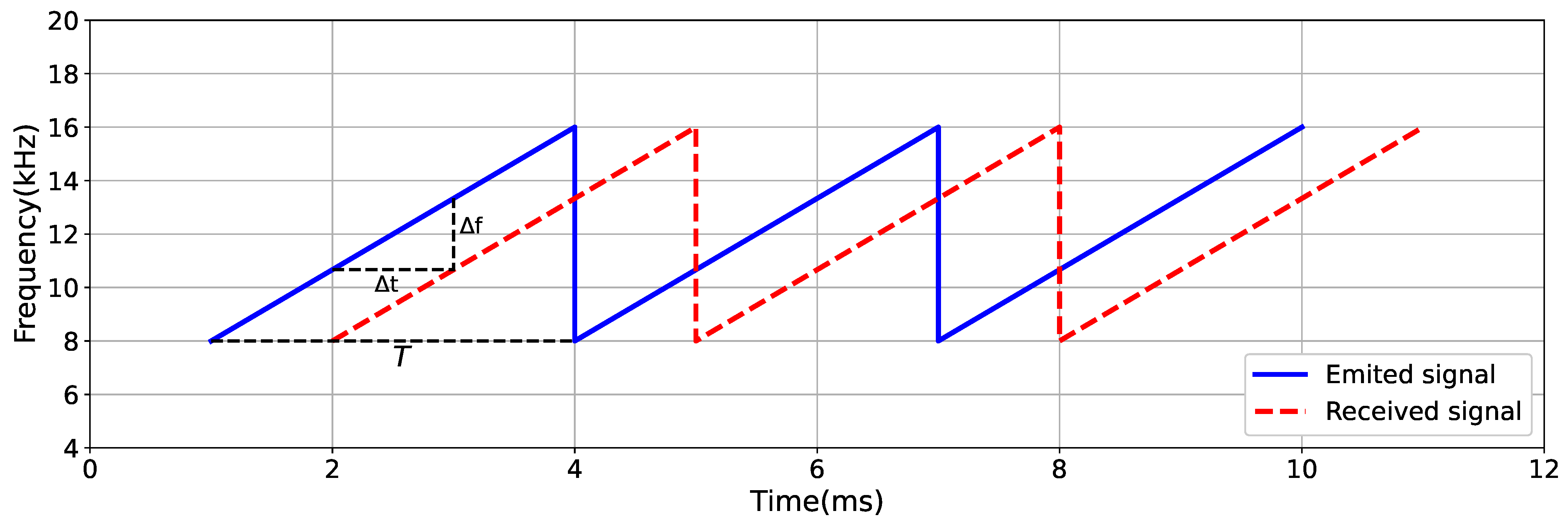
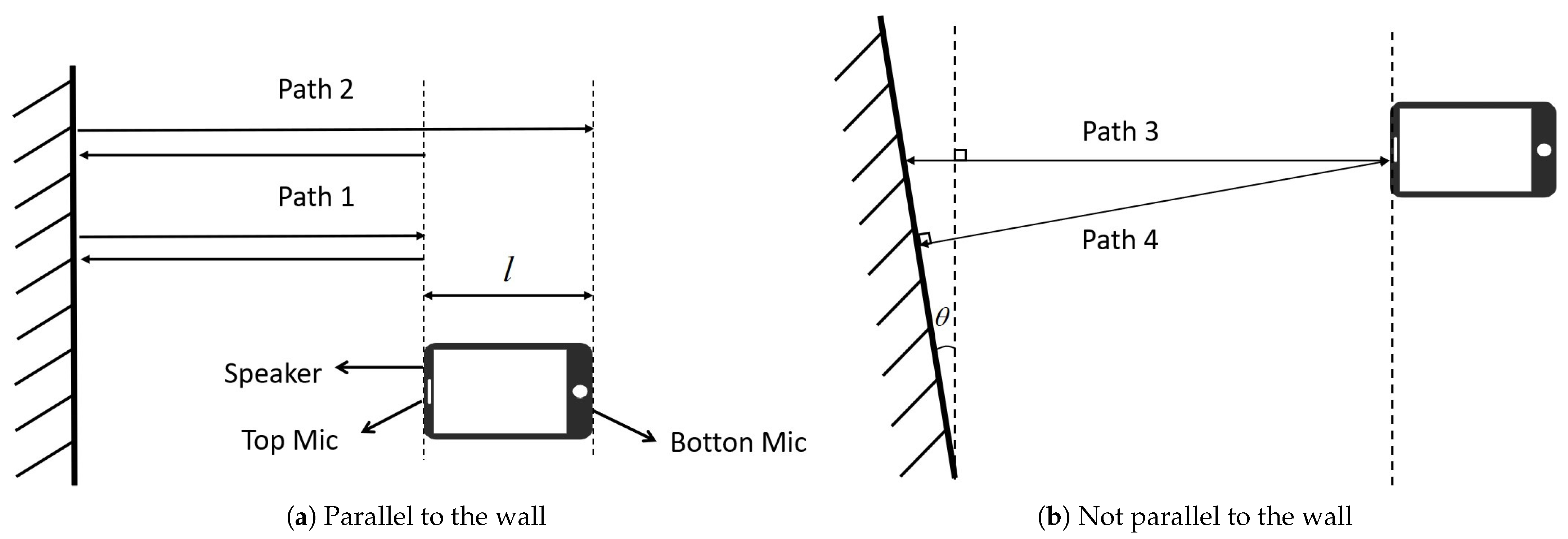


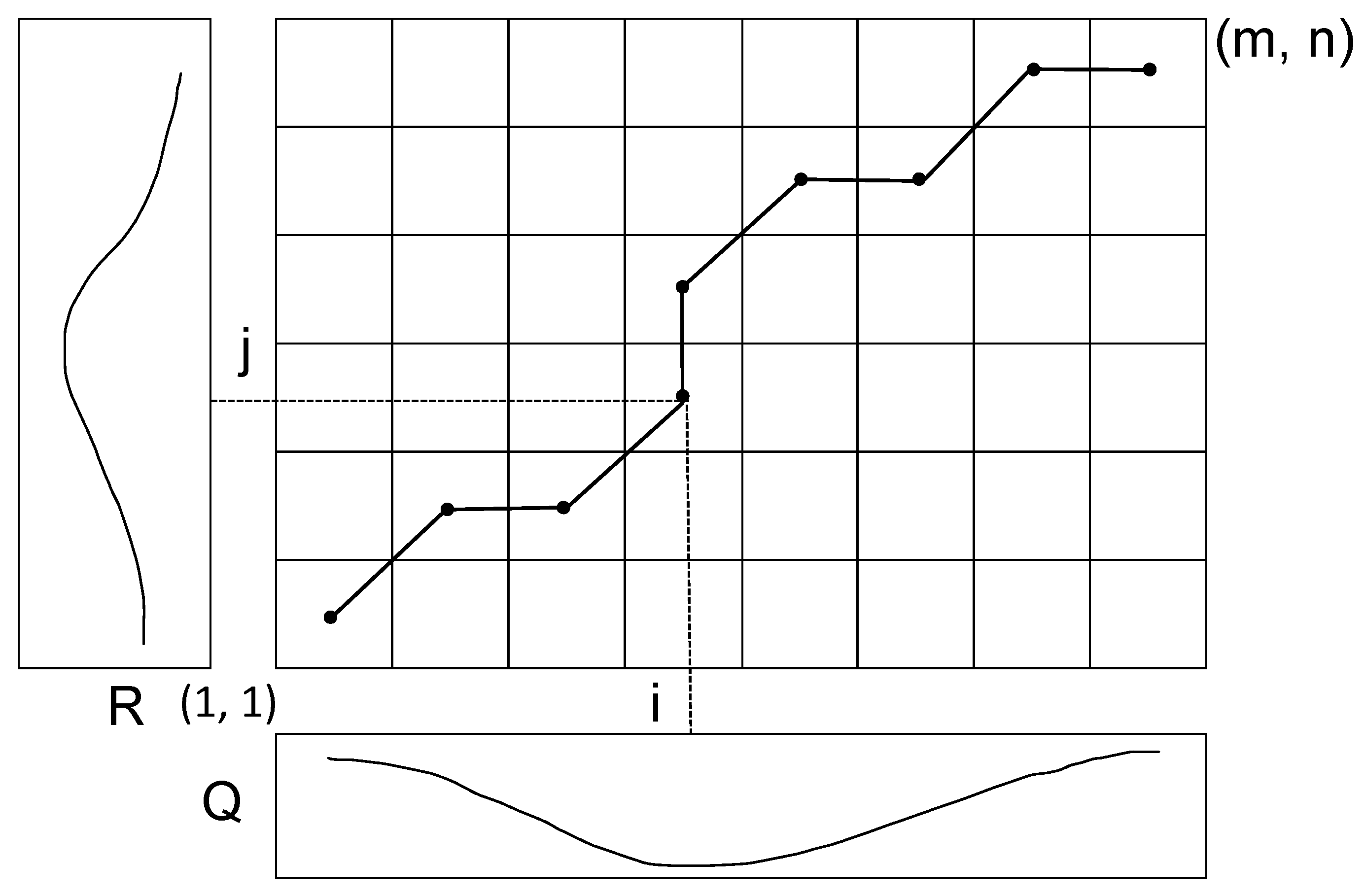
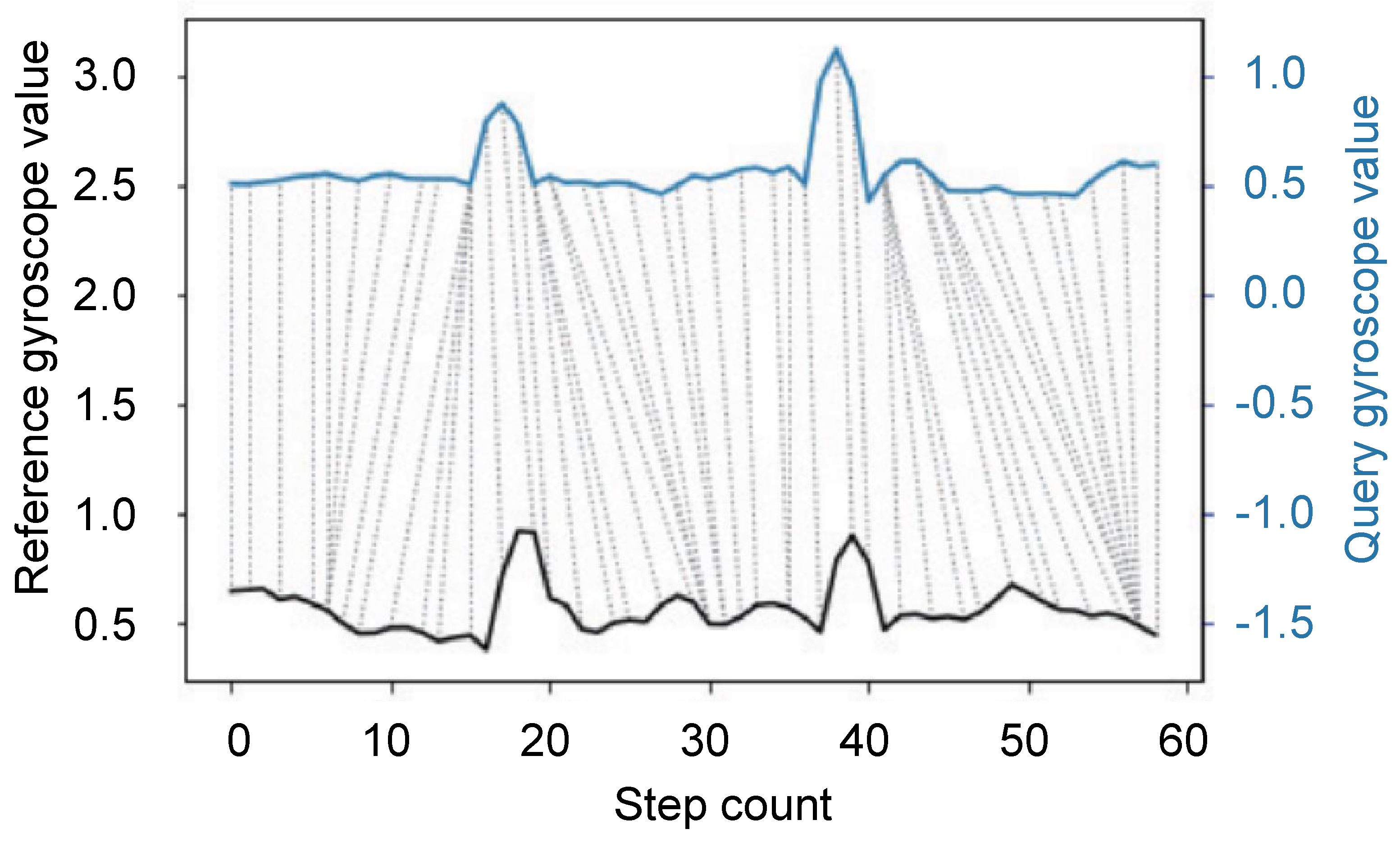


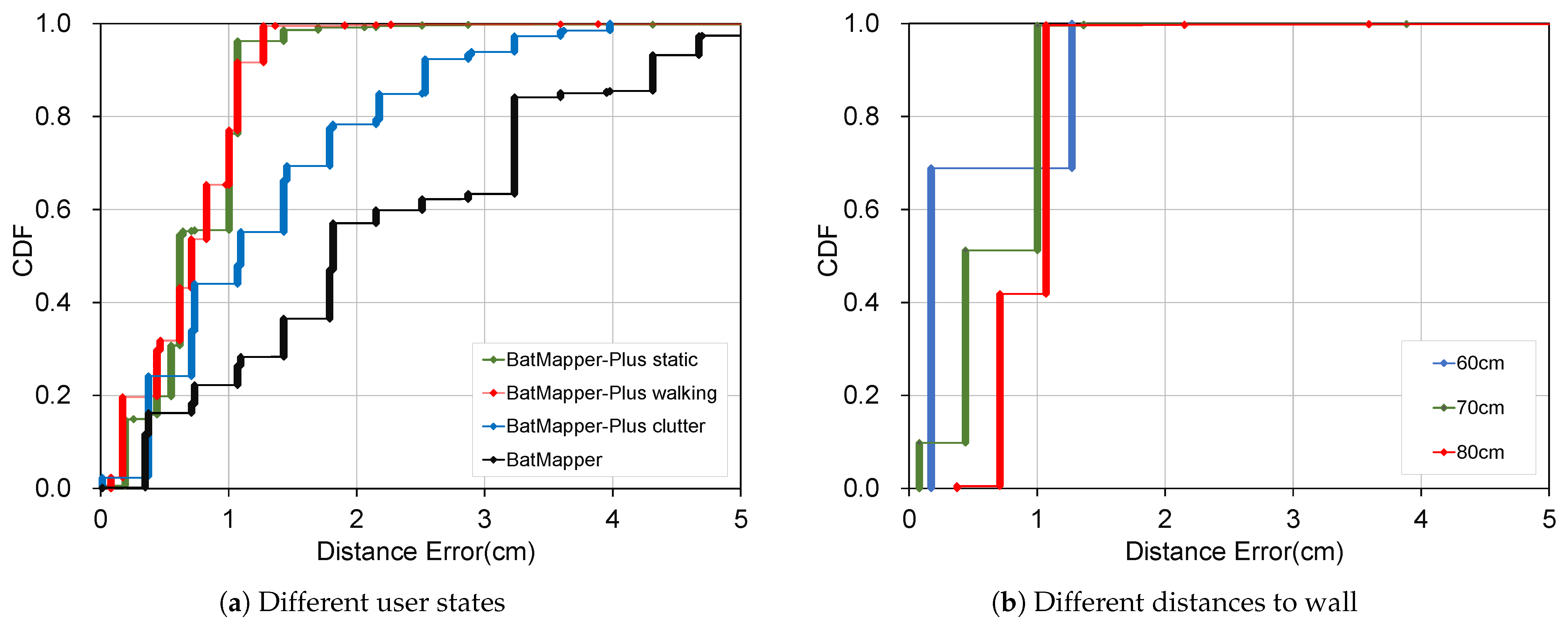






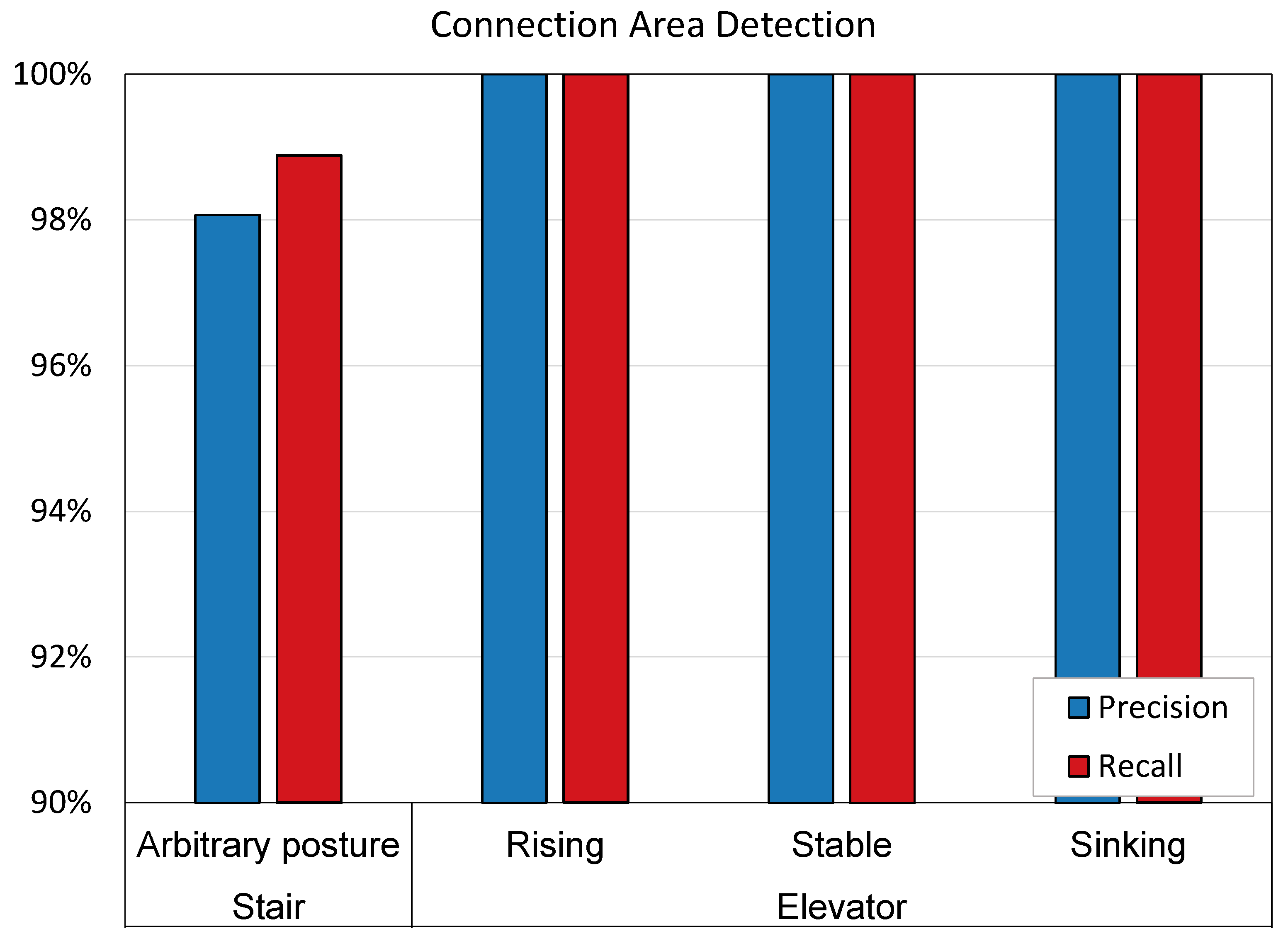
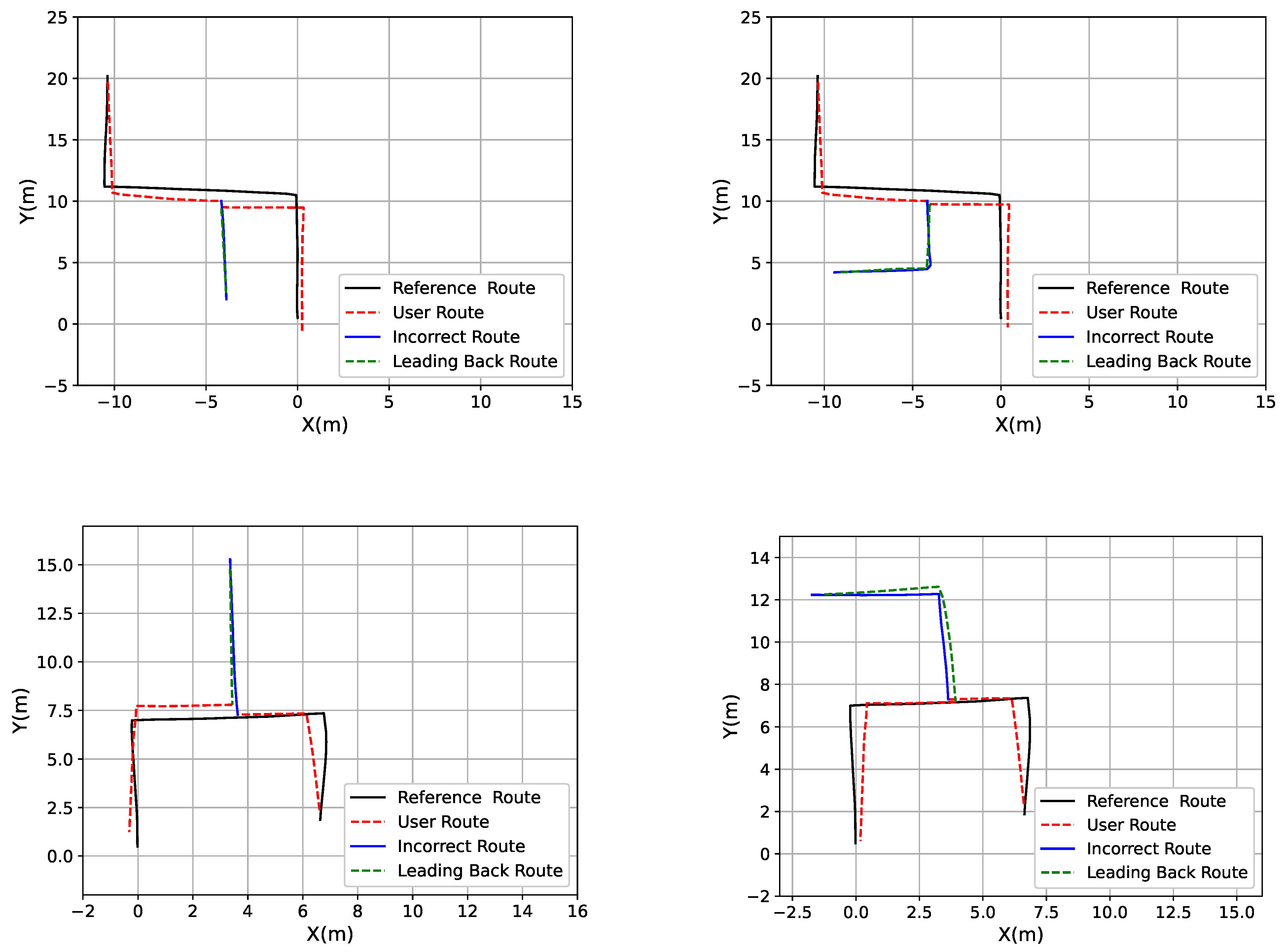

| Scenario | Classroom | Living Room | Corridor | ||||||
|---|---|---|---|---|---|---|---|---|---|
| Criterion | R (%) | P (%) | F (%) | R (%) | P (%) | F (%) | R (%) | P (%) | F (%) |
| CrowInside | 77.28 | 100 | 87.18 | 74.80 | 100 | 85.58 | 58.82 | 100 | 74.07 |
| BatMapper | 96.36 | 99.61 | 97.96 | 97.46 | 96.21 | 96.58 | 84.71 | 94.12 | 89.17 |
| BatMapper-Plus | 97.89 | 99.48 | 98.68 | 99.05 | 98.46 | 98.75 | 97.65 | 91.76 | 94.61 |
| Scenario | Scenario1 | Scenario2 | Scenario3 | ||||||
|---|---|---|---|---|---|---|---|---|---|
| Criterion | R (%) | P (%) | F (%) | R (%) | P (%) | F (%) | R (%) | P (%) | F (%) |
| Fixed | 83.93 | 96.79 | 89.90 | 83.23 | 89.32 | 86.17 | 80.66 | 97.99 | 88.48 |
| Dynamic | 93.07 | 95.61 | 94.32 | 97.00 | 79.09 | 87.13 | 94.65 | 96.05 | 95.35 |
Disclaimer/Publisher’s Note: The statements, opinions and data contained in all publications are solely those of the individual author(s) and contributor(s) and not of MDPI and/or the editor(s). MDPI and/or the editor(s) disclaim responsibility for any injury to people or property resulting from any ideas, methods, instructions or products referred to in the content. |
© 2023 by the authors. Licensee MDPI, Basel, Switzerland. This article is an open access article distributed under the terms and conditions of the Creative Commons Attribution (CC BY) license (https://creativecommons.org/licenses/by/4.0/).
Share and Cite
Meng, C.; Jiang, S.; Wu, M.; Xiao, X.; Tao, D.; Gao, R. Smartphone-Based Indoor Floor Plan Construction via Acoustic Ranging and Inertial Tracking. Machines 2023, 11, 205. https://doi.org/10.3390/machines11020205
Meng C, Jiang S, Wu M, Xiao X, Tao D, Gao R. Smartphone-Based Indoor Floor Plan Construction via Acoustic Ranging and Inertial Tracking. Machines. 2023; 11(2):205. https://doi.org/10.3390/machines11020205
Chicago/Turabian StyleMeng, Chuize, Shan Jiang, Mengning Wu, Xuan Xiao, Dan Tao, and Ruipeng Gao. 2023. "Smartphone-Based Indoor Floor Plan Construction via Acoustic Ranging and Inertial Tracking" Machines 11, no. 2: 205. https://doi.org/10.3390/machines11020205
APA StyleMeng, C., Jiang, S., Wu, M., Xiao, X., Tao, D., & Gao, R. (2023). Smartphone-Based Indoor Floor Plan Construction via Acoustic Ranging and Inertial Tracking. Machines, 11(2), 205. https://doi.org/10.3390/machines11020205








